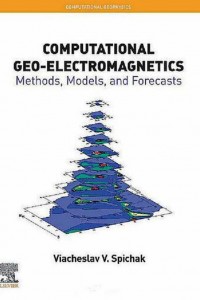Computational Geo-Electromagnetics: Methods, Models, and Forecasts
Viacheslav V. Spichak

Informasi Umum
Kode
20.21.2146
Klasifikasi
910.285 - Geographic information systems
Jenis
Buku - Elektronik (E-Book)
Subjek
Geographical Information Systems, Electromagnetic Theory, Computational Intelligence,
No. Rak
Dilihat
138 kali
Informasi Lainnya
Abstraksi
The book has three parts. In Part I (Methodology of EM data interpretation) two alternative approaches to EM data inversion are considered: the Bayesian statistical inversion and neural networkebased algorithms. The former one provides flexible tools for taking into account prior information and expert estimates during EM data inversion and quantifying its results in terms of posterior parameters’ uncertainties. The latter one is especially useful in the case of constructing 3-D models (in particular, in terms of macroparameters) from sparse, irregularly distributed or a single-profile electromagnetic data. Finally, a review of the methods used for joint analysis and inversion of EM and other geophysical data is presented.
In Part II (Models of geological medium) the approaches considered in the Part I are applied to study methodological issues of EM modeling volcanoes (by examples of Vesuvio, Kilauea, Elbrus, Komagatake, Hengill), geothermal and hydrocarbon reservoirs. Conceptual models of the Icelandic type crust, a lens in the upper crust and copper-porphyry ore formation are suggested based on joint analysis of EM and other geophysical data.
In Part III (Forecasting petrophysical properties of rocks) the techniques for estimating temperature, seismic velocities, and porosity from the electrical resistivity as proxy parameter are considered. This part is supplemented by Appendix, which includes useful empirical relations between electrical resistivity, seismic velocities and porosity.
- TTI3E1 - PRAKTIKUM TEKNIK TELEKOMUNIKASI 3
- AAK3AAB1 - Praktikum Teknik Telekomunikasi 3
Koleksi & Sirkulasi
Tersedia 1 dari total 1 Koleksi
Anda harus log in untuk mengakses flippingbook
Pengarang
| Nama | Viacheslav V. Spichak |
| Jenis | Perorangan |
| Penyunting | |
| Penerjemah |
Penerbit
| Nama | Elsevier |
| Kota | Amsterdam |
| Tahun | 2020 |
Sirkulasi
| Harga sewa | IDR 0,00 |
| Denda harian | IDR 0,00 |
| Jenis | Non-Sirkulasi |



















